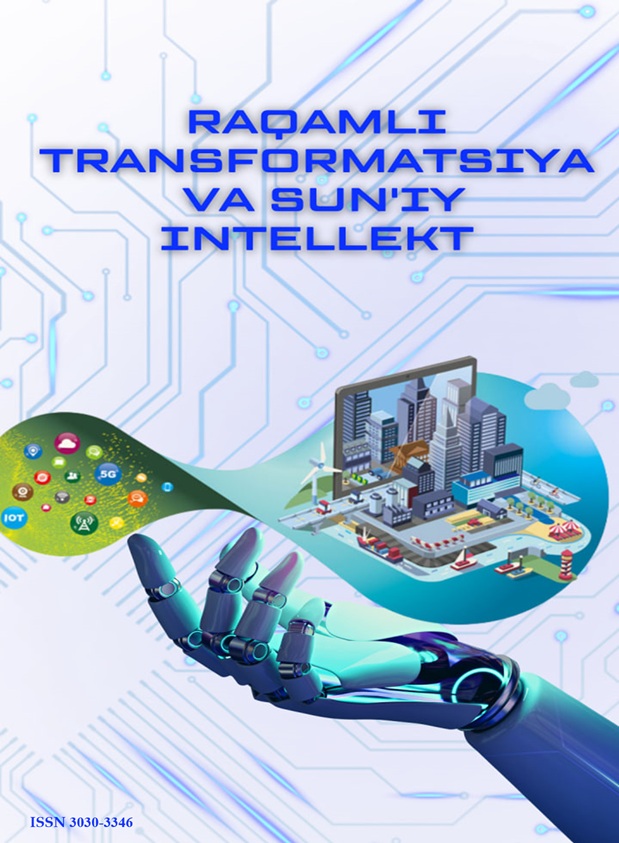ИНСОН ҲИС-ТУЙҒУЛАРИНИ АНИҚЛАШНИНГ НЕЙРОН ТАРМОҚ МОДЕЛЛАРИ
Keywords:
нейрон тармоқ, ҳис-туйғу, юз ифодаси, CNN, RNN, LSTM, EmotionNet Nano, TensorFlow, PyTorch, DeepFace, интеллектуал тизимAbstract
Мазкур мақола инсон юз ифодалари орқали унинг ҳис-туйғуларини аниқлашда фойдаланиш мумкин бўлган нейрон тармоқ моделлари таҳлилига бағишланган бўлиб, унда ҳис-туйғуларни автоматик аниқлашга оид классик ва замонавий ёндашувлар таҳлили амалга оширилган. Шунингдек, мақолада чуқур нейрон тармоқлар ва уларни гибрид моделлари орқали ҳис-туйғуларни аниқлашдаги имкониятлари, архитектуралари, трансферли ўқитиш ва оптималлаштириш усуллари ҳам кенг ёритилган. EmotionNet Nano моделини юз ифодаларини аниқлашдаги самарадорлиги, кичик ўлчами ва энергия тежамкорлиги билан бошқа моделлардан ажралиб туриши кўрсатилиб, уни реал вақтда ишлашга мослаштирилган ечим эканлиги таъкидлаб ўтилган. Модел CK+, FER-2013 каби маълумотлар базаларидаги юқори аниқликни таъминлаганлиги уни амалиётда жорий этишга яроқлилигини кўрсатади. Бундан ташқари, Python дастурлаш муҳитидаги мавжуд OpenCV, Dlib, DeepFace, FER ва ERTK/Affectiva каби кутубхоналарни таҳлил қилиниб, уларни ҳис-туйғуларни аниқлашдаги имкониятлари ўрганилган ҳамда турли базаларда тажриба синов натижалари келтирилган. Олинган натижалар OpenCV, Dlib, TensorFlow ва PyTorch каби технологик воситалардан фойдаланиб реал вақтда ишловчи, енгил ва самарали тизимларни яратиш мумкинлигини кўрсатди. Муаллифлар инсон ҳис-туйғуларини аниқлашда нейрон тармоқ моделларидан фойдаланиш нафақат назарий жиҳатдан, балки амалий жиҳатдан ҳам улкан имкониятларга деб ҳисоблайдилар.
References
Zhao-yi, P., Yan-hui, Z., & Yu, Z. (2010). Real-time facial expression recognition based on adaptive canny operator edge detection. In 2010 S International Conference on Multimedia and Information Technology (pp. 154–157). KaifengChin: IEEE. https://doi.org/10.1109/MMIT.2010.100.
Zhang, J. Z., Qin, Z., Tay, P. C., & Adams, R. D. (2010). A novel facial expression recognition method using fast BEMD based edge detection. In 2010 Conference Record of the Forty Fourth Asilomar Conference on Signals, Systems and Computers (pp.204–208). Pacific Grove, CA: IEEE. https://doi.org/10.1109/ACSSC.2010.5757499.
K. Mohan, A. Seal, O. Krejcar, and A. Yazidi, “Facial expression recognition using local gravitational force descriptor-based deep convolution neural networks,” IEEE Transactions on Instrumentation and Measurement, vol. 70, pp. 1–12, 2020.
N. M. Rezk, M. Purnaprajna, T. Nordström, and Z. Ul-Abdin, “Recurrent neural networks: an embedded computing perspective,” IEEE Access, vol. 8, pp. 57967–57996, 2020.
R. Parhi and R. D. Nowak, “The role of neural network activation functions,” IEEE Signal Processing Letters, vol. 27, pp. 1779–1783, 2020.
R.-Y. Sun, “Optimization for deep learning: an overview,” Journal of the Operations Research Society of China, vol. 8, no. 2, pp. 249–294, 2020.
I. C. Peace, A. O. Uzoma, and S. A. Ita, “Effect of learning rate on artificial neural network in machine learning,” International Journal of Engineering Research & Technology, vol. 4, 2015.
J. Liu, H. Wang, and Y. Feng, “An end-to-end deep model with discriminative facial features for facial expression recognition,” IEEE Access, vol. 9, pp. 12158–12166, 2021.
S. Li and W. Deng, “Reliable crowdsourcing and deep locality-preserving learning for unconstrained facial expression recognition,” IEEE Transactions on Image Processing, vol. 28, pp. 356–370, 2018.
P. T. Vinh and T. Quang Vinh, “Facial expression recognition system on SoC FPGA,” in 2019 International Symposium on Electrical and Electronics Engineering (ISEE), pp. 1–4, IEEE, Ho Chi Minh City, Vietnam, October 2019.
S. Singh and F. Nasoz, “Facial expression recognition with convolutional neural networks,” in 2020 10th Annual Computing and Communication Workshop and Conference pp. 324–328, IEEE, Las Vegas, NV, USA, January 2020.(CCWC),
R. A. Borgalli and S. Surve, “Deep learning framework for facial emotion recognition using CNN architectures,” in 2022 International Conference on Electronics and Renewable Systems (ICEARS), pp. 1777–1784, IEEE, Tuticorin, India, March 2022.
S.J.Pan and Q. Yang, “A survey on transfer learning,” IEEE Transactions on Knowledge and Data Engineering, vol. 22, no. 10, pp. 1345–1359, 2010.
J. Yosinski, J. Clune, Y. Bengio, and H. Lipson, “How transferable are features in deep neural networks?” Proceedings of the 27th International Conference on Neural Information Processing Systems, vol. 2, pp. 3320–3328, 2014.
S. Wen, W. Liu, Y. Yang et al., “Multilabel image classification via feature/label coprojection,” IEEE Transactions on Systems, Man, and Cybernetics: Systems, vol. 51, no. 11, pp. 7250–7259, 2021.
S. Wen, M. Dong, Y. Yang, P. Zhou, T. Huang, and Y. Chen, “End-to-end detection-segmentation system for face labeling,” IEEE Transactions on Emerging Topics in Computational Intelligence, vol. 5, no. 3, pp. 457–467, 2021.
S. Wen, J. Chen, Y. Wu et al., “CKFO: convolution kernel first operated algorithm with applications in memristor-based convolutional neural network,” IEEE Transactions on Computer- Aided Design of Integrated Circuits and Systems, vol. 40, no. 8, pp. 1640–1647, 2021.
T.-H. S. Li, P.-H. Kuo, T.-N. Tsai, and P.-C. Luan, “CNN and LSTM based facial expression analysis model for a humanoid robot,” IEEE Access, vol. 7, pp. 93998–94011, 2019.
K. Yan, W. Zheng, T. Zhang et al., “Cross-domain facial expression recognition based on transductive deep transfer learning,” IEEE Access, vol. 7, pp. 108906–108915, 2019.
M. Akhand, S. Roy, N. Siddique, M. A. S. Kamal, and T. Shimamura, “Facial emotion recognition using transfer learning in the deep CNN,” Electronics, vol. 10, no. 9, Article ID 1036, 2021.
Tehmina Kalsum, Zahid Mehmood, “A Novel Lightweight Deep Convolutional Neural Network Model for Human Emotions Recognition in Diverse Environments”, Hindawi Journal of Sensors Volume 2023, Article ID 6987708, https://doi.org/10.1155/2023/6987708
Monisha, G. S., Yogashree, G. S., Baghyalaksmi, R., & Haritha, P. (2023). Enhanced automatic recognition of human emotions using machine learning techniques. Procedia computer science, 218, 375–382. https://doi.org/10.1016/j. procs.2023.01.020
Li, T.-H. S., Kuo, P.-H., Tsai, T.-N., & Luan, P.-C. (2019). CNN and LSTM based facial expression analysis model for a humanoid robot. IEEE access : practical innovations, open solutions, 7, 93998–94011. https://doi.org/10.1109/ACCESS.2019.2928364
Joshi, V. M., Ghongade, R. B., Joshi, A. M., & Kulkarni, R. V. (2022). Deep BiLSTM neural network model for emotion detection using cross-dataset approach. Biomedical Signal Processing And Control, 73(103407), 1–10. https://doi.org/10.1016/j. bspc.2021.103407
Mishra, R. K., Urolagin, S., Arul Jothi, J. A., & Gaur, P. (2022). Deep hybrid learning for facial expression binary classifications and predictions. Image and Vision Computing, 128(104573), 1–12. https://doi.org/10.1016/j.imavis.2022.104573
Ullah, Z., Qi, L., Hasan, A., & Asim, M. (2022). Improved deep cnn-based two stream super resolution and hybrid deep model-based facial emotion recognition. Engineering Applications Of Artificial Intelligence, 116(105486), 1–14. https://doi.org/10.1016/j.engappai.2022.105486
Durga, B. K., & Rajesh, V. (2022). A ResNet Deep Learning Based Facial Recognition Design For Future Multimedia Applications. Computers & Electrical Engineering : An International Journal, 104(108384), 1–17. https://doi.org/10.1016/j.compeleceng.2022.108384
Haposan V.M , Achmad P.R, “Detection of human emotions through facial expressions using hybrid convolutional neural network-recurrent neural network algorithm”, Intelligent Systems with Applications 21 (2024)
Yassine E.B, Amine B., “EmoNeXt: an Adapted ConvNeXt for Facial Emotion Recognition”, arXiv:2501.08199v1 [cs.CV] 14Jan2025
Yini Fang, Alec Diallo, Yiqi Shi, Frederic Jumelle, Bertram Shi, “End-to-End Facial Expression Detection in Long Videos”, arXiv:2504.076660v1 [cs.CV] 10Apr2025
James R.L., Linda W., Alexander W., “EmotionNet Nano: An Efficient Deep Convolutional Neural Network Design for Real-Time Facial Expression Recognition”, (2021) Front. Artif. Intell. 3:609673. doi: 10.3389/frai.2020.609673
Jiawei Mao, Rui Xu, Xuesong Yin, Yuanqi Chang, Binling Nie, Aibin Huang, “A simpler and stronger facial expression recognition network”, arXiv:2301.12149,https://doi.org/10.48550/arXiv.2301.12149
arXiv:2301.12149
Bhagyashri Devi, M. Mary S.J.P, “Facial emotion recognition using convolutional neural network based krill head optimisation”, Expert Systems Volume 42, Issue 1, 2023 https://doi.org/10.1111/exsy.13376
GitHub - Xionghc/Facial-Expression-Recognition: Facial-Expression-Recognition in TensorFlow. Detecting Faces in Video and Recognize the Expression
Martin Magdin, “Real Time Facial Expression Recognition Using Webcam and SDK Affectiva” 2017.
GitHub - WuJie1010/Facial-Expression-Recognition.Pytorch: A CNN Based Pytorch Implementation on Facial Expression Recognition
Downloads
Published
Issue
Section
License
Copyright (c) 2025 Маматов Нарзилло Солиджонович, Ниёзматова Нилуфар Аълохановна, Тожибоева Шахзода Холдоржон қизи, Машанпин Тимур Васикович, Яхяев Бахромжон Юсуфович

This work is licensed under a Creative Commons Attribution 4.0 International License.












